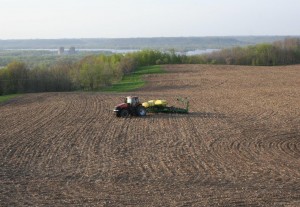
A buffer strip along the edge of this field in southern Minnesota helps prevent soil and nutrient runoff into the nearby river.
At a DNR roundtable event in January, Minnesota Gov. Mark Dayton told the audience that he would ask the legislature to require a 50-foot buffer along all Minnesota waterways. Details of the governor’s proposal have not been revealed and legislation has yet to be introduced.
Nonetheless, the proposal has generated a lot of discussion. That discussion will likely pick up in the coming weeks if legislation is actually introduced to implement the governor’s 50-foot buffer proposal. Meantime, here are answers to frequently asked questions about buffer strips, with a particular focus on how buffers relate to farming in Minnesota.
What is a buffer strip?
An area of land along a water body maintained in permanent vegetation that is not tilled or used to grow annual crops. On farmland, the primary purpose of buffers is to prevent the direct movement of soil containing nutrients like fertilizer into streams and ditches.
Are Minnesota farmers currently using buffer strips?
Yes. Fortunately, most Minnesota streams are already protected by buffers, as evidenced by studies conducted by several Minnesota counties. Buffer strips are a common conservation practice used by farmers, along with grass waterways, terraces, sediment basins and wetlands.
Why does Gov. Dayton want 50 feet of buffer along all waterways?
The governor is responding to recent criticisms from hunting organizations and activist groups that feel pheasant habitat is dwindling due to an increase in row cropping. The governor also cited water quality concerns as another reason for his proposal.
Has a significant amount of habitat for pheasants and other wildlife been converted to cropland in recent years?
According to USDA’s National Ag Statistics Services, as global demand for food has increased, the area planted to all row crops in Minnesota grew by less than one percent from 2007-2014.
Are there currently any existing laws that require buffer strips?
Yes. Minnesota is the only state to require a 50-foot buffers along river, streams, and lakes. There is flexibility in the law, however, that allows counties to require wider or narrower buffers if local conditions make a 50-foot buffer impractical. A drainage law also requires a 16.5-foot buffer along some, but not all, drainage ditches.
If Minnesota already has laws pertaining to buffers, why is the Governor proposing another one?
Currently, it’s up to individual counties to enforce existing buffer rules and laws. Some counties strictly enforce buffer requirements and report high compliance. Others do not enforce as strictly. While making his proposal, Gov. Dayton indicated that he would like to see the DNR take over enforcement of Minnesota buffer requirements statewide.
Will the governor’s proposal impact only farmland? Or will buffers also be required in urban areas, lakeshore homes or along roadways?
The governor said “all waterways.” But since no details have been made available or official legislation introduced, we don’t know for sure.
Do buffers help protect water quality?
Yes. However, it’s not as easy as finding a one-size-fits-all buffer strip solution for all waterways. Ideally, every stream and ditch mile would be protected by at least a few feet of buffer. For some streams, a few feet of buffer is adequate. For others, larger buffers — even buffers larger than 50 feet — might be necessary.
Would cropland converted to buffers qualify for conservation funding?
We don’t know, because details of the governor’s proposal have not been revealed yet. In general, the required portion of buffers associated with ditch projects are funded as part of the overall ditch project, with costs spread among all landowners who benefit from the ditch. Buffers along streams and lakes are sometimes funded through programs like the Conservation Reserve Program or Reinvest in Minnesota.
Who could I speak with for more information on buffer strips and the governor’s proposals?
The Minnesota Agricultural Water Resource Center is very helpful. The Minnesota Corn Growers Association is also able to offer insight. You can find contact info for both organizations by clicking on their link.

